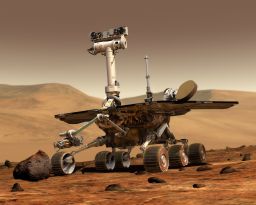A.J.S. Rayl • Jun 30, 2006
Mars Exploration Rovers Update: Spirit Discovers More Meteorites as Opportunity Closes in
on Beagle Crater
The Mars Exploration Rovers (MER) are wheel deep in winter, and still faring well, working hard, and sending home interesting new finds despite the below freezing Martian temperatures. The next month or so will bring the season's coldest temperatures to the rover's present habitats, but so far, no one on the team is losing any sleep over whether or not they'll make it through, because these rovers just keep going and going . . .
At Gusev Crater, Spirit uncovered two more meteorites while working its winter campaign at Low Ridge, near McCool Hill in the Columbia Hills. Even more intriguing, the rover found calcium sulfates in the target Halley, "That's a significant recent finding, and it was a real surprise," said Steve Squyres, rover principal investigator, of Cornell University, in an interview yesterday. It is,in essence, yet another clue that water flowed there in the past.
On the other side of the planet, Opportunity's drivers got the rover out of the sand jam it got into over the Memorial Day weekend when it partially buried its wheels in loose topsoil as it was repositioning itself to make another run toward Victoria crater, the next major destination. After an intricate extraction process consisting of 6 similar, precision sequences the rover was out of Jammerbugt, onto outcrop, and back on the Meridiani highway on June 8. The rover is currently crossing treacherous terrain, slowly closing in on Beagle crater, the last major roadside attraction before Victoria.
All in all, the rovers are doing extremely well, although energy is low, which is somewhat frustrating the science team long spoiled by the resilience of these twin robot field geologists. Spirit has only been getting about one-third as much solar energy as it received in mid-2005 while on Husband Hill or an average of about 300 watt-hours per Martian sol, according to Bruce Banerdt, MER project scientist, of the Jet Propulsion Laboratory (JPL). (One hundred watt-hours is the amount of electricity needed to light one 100-watt bulb for one hour.) The power supply determines how much work Spirit can do each sol, and at this point the rover is lethargic, able only to work for very, very limited periods of time, minutes not hours. Even so, Spirit is rising to the challenge and multi-tasking to keep up with a fairly aggressive workload.
Opportunity's energy levels are higher and will no doubt remain that way since this rover is closer to the equator. Still, this rover's levels in the low 400s are not that much more energetic. In fact, it was when the rover was trying to reposition itself for a better angle to the Sun that it got stuck in Jammerbugt on Memorial Day weekend.
Both rovers' instruments continue to hold up remarkably well. Spirit suffered a stall on its rock abrasion tool (RAT) this month and Opportunity experienced a glitch with its Mössbauer spectrometer when its reference channel began exhibiting intermittent behavior. Still, Squyres remained confident Spirit would be picking up its RAT brush again soon, and Banerdt pointed out that that despite the Mössbauer issue on Opportunity, the science quality of the data collected has not been affected, and periodic calibrations can still be done with the external Composition Calibration Target (CCT).
Even though the rovers are operating almost seamlessly, the team has been uploading new flight software. said Banerdt. "It takes quite a while to send all the new software files up and so the process is ongoing and will continue for the next month or so." Once all the files are uploaded, the software engineers must then make sure "no bits flipped" and that everything is operating as designed. "Then they double-check everything again," said Banerdt. Then at some point probably in August, the new flight software will be booted up.
While there are some "bug fixes" in the new software, "more importantly," Version R9.2 will upgrade the rovers' capabilities, said Banerdt. The software, for example, improves the automated mobility capabilities so the rovers can drive longer distances before checking back with Earth, or be able to rove through more complex terrain in a smarter way, better able to handle the complexities of Martian surface. The new software will also allow the rovers to take IDD measurements on rocks in a more autonomous way, so that at the end of a drive, Spirit and Opportunity can put their IDDs on a rock and take measurements without stopping to update their position and radio back to Earth and wait for the team to figure out where to put the arm and then uplink new commands. "That alone will save a day of commanding and allow more science to come down from rovers in same amount of time," said Banerdt.
On top of all those nice new features, the MER rovers will have a newfound ability to look at transient phenomena, such as clouds and dust devils, in a more economical way, by zooming in on the one section of an image that changes and imaging only that. "What this software does is allow [some of the cameras] to take a whole picture and compare it to the next picture, zoom in on the piece that's changed and return that piece of the picture -- the dust devil, say -- so that the rest of it -- the background -- which is exactly the same image to image doesn't have to be brought down again, which wastes so much needed [memory] space onboard," he explained. "This way we can bring back more useful information about those about those kinds of phenomena more efficiently. We've got lots of Martian pink sky pictures already."
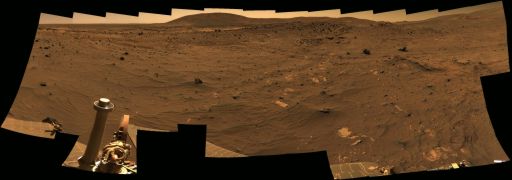 The view northward
The view northwardOne part of the winter science campaign that Spirit is conducting while sitting at a favorable location for wintertime solar energy is the most detailed panorama yet taken on the surface of Mars. This view is a partial preliminary product from the continuing work on the full image, which will be called the McMurdo Panorama. Spirit began taking exposures for the humongous panorama on Sol 814 (April 18, 2006) and is currently about ¾ of the way through the process, according to lead rover scientist Steve Squyres, taking exposures through all of the Pancam mineralogy filters and using little or no image compression. Even with a tilt toward the winter Sun, the amount of energy available daily is small, so the job will still take another month or so to complete. This view looks toward the north. Husband Hill, which the rover was climbing a year ago, is on the horizon near the center. Home Plate is a between that hill and the rover's current position. This is an approximate true-color rendering combining exposures taken through three PanCam filters.
Credit: NASA / JPL / Cornell / USGS
Spirit From Gusev Crater
Spirit is hunkered down in the harshness of winter, but hasn't let its lack of energy keep it from putting in a good day's work, day after day. And that work is paying off big, once again.
The rover spent the first day of June acquiring another column of images for the 27-column McMurdo panorama, which will be the largest panorama taken to date on the MER mission. During the ensuing week or so, despite its low energy, Spirit brushed away another 2 millimeters of soil from Progress, abrading down to the layer known as Progress 3, collected images with its microscopic imager (MI), conducted remote sensing of land targets and of the atmosphere, took a 360-degree view of its surroundings with the navigation camera, and a series of forward views through the front hazard avoidance camera, and collected another couple of columns of images for the McMurdo pan.
The winter cold, meanwhile, really set in this month at Gusev. For the first time on either rover, Spirit's battery heaters turned on at 8:15 a.m. local solar time on Mars on Sol 865 (June 9). Basically, that means temperatures dropped to at least -19 degrees Celsius (-2 degrees Fahrenheit), because the heaters activate automatically at that point. The lowest allowable operating temperature for the rovers is -20 degrees C (-4 degrees F.).
Spirit didn't skip a beat, however, and began work on 2 new projects right on schedule. For one, known as a "photon transfer calibration" study, the rover measured electronic noise -- or unwanted signals -- picked up by sensors in its 9 cameras. [These sensors are the charge-coupled devices or CCDs that convert light into electrical current.] As the month progressed, the rover completed the photon transfer calibration study on all the cameras, including its panorama camera (PanCam), rear hazard-avoidance and front hazard-avoidance cameras, and the microscopic imager.
For the other project, Spirit is looking for wind-driven changes in the Martian surface by imaging a bright, previously studied soil target named Tyrone, every month for the next few months, using all 13 filters of the PanCam. Here and there, the rover has also been taking high-resolution images with the PanCam of interesting targets, including one dubbed Korolev, on Sol 873 (June 17).
To keep up the pace, especially with such low energy, Spirit, like its twin Opportunity, has become a master multi-tasker. On Sol 869 (June 13), for example, the rover made targeted observations of rock targets dubbed Riquelme and Zucchelli while talking with Odyssey to down-link other, stored data. Just 2 sols later, Spirit checked out rock targets named Law-Ricovita, Tor, Scott Base, and Arctowski with its mini-TES while communicating with Odyssey as it passed overhead. Importantly, the rover's multi-tasking has been successful and efficient, which, of course, cannot always be said of human multi-tasking.
In mid-month, during the work on Progress 3, the rock abrasion tool (RAT) stalled, which, in turn, stalled the completion of the layer-by-layer soil analysis experiment on Progress, and put the RAT in rehab. "We're brushing in soil, and this thing was not really designed to do that, so we had the RAT stall last time we tried to use it in Progress 3," confirmed Squyres. "That's not surprising," he added. "In fact, I kind of thought it was going to happen earlier. Just to be on the safe side, before we continue, we want to do some diagnostics, just limber the thing up and make sure everything's okay."
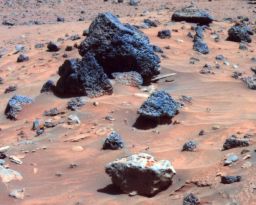 Allan Hills -- on Mars
Allan Hills -- on MarsThe light gray toned rock in the center foreground of this picture is suspected of being an iron meteorite. Spirit took this image with the PanCam during Sol 809 (April 12, 2006), not long after arriving at its winter haven, Low Ridge. This rock, dubbed Allan Hills, and a similar rock named Zhong Shan, just out of the field of view to the left, have a smoother texture and lighter tone than other rocks in the area. The texture and glossiness of this pair reminded some members of the rover science team of a rock called Heat Shield Rock, which was observed by Opportunity in the Meridiani region of Mars more than a year ago. Examination of that rock's composition confirmed it to be an iron meteorite. This view is a false-color rendering to emphasize differences among rock and soil materials.
Credit: NASA / JPL-Caltech / Cornell
Last week, Spirit completed the 22nd column of the McMurdo pan, completed the seventh of 9 photo transfer calibration studies on the rover's 9 cameras, conducted more remote sensing on rocks with the mini-TES, and took a panoramic picture of the El Dorado dune field, and images of its own tracks, as well as completed a dust monitoring assessment of the PanCam's mast assembly. The rover also conducted in-depth studies of a soil target dubbed Halley Brunt, an undisturbed exposure of bright, sparkling bits of soil near the rover's left front wheel. The work included a 5-hour examination with the alpha particle x-ray spectrometer (APXS), and a 10-hour observation with the Mössbauer spectrometer, as well as taking a series of MI pictures.
Down on the ground, the science team has been scrutinizing and analyzing the data as it's been coming down -- and two significant finds -- one large, one small -- emerged this month -- in the form of meteorites and calcium sulfates.
Although Spirit and the team homed in on two unusual pitted rocks shortly after the rover pulled into Low Haven on Sol 807 (April 10, 2006), the team only recently confirmed that they are in all probability meteorites. "When we first got [to Low Ridge], we noticed two rocks just a few meters from the rover that looked unusual in some of the first PanCam images," Squyres recalled. "What looked unusual about them is they were kind of grayish, as opposed to red or brown, and they had a pitted appearance to their surfaces, both of which are characteristics that meteorites tend to have." Suspecting that they might be meteorites that may have originated from an asteroid and landed on Mars, the team named one of them Allan Hills. "Recall that we're naming all the rocks after Antarctic research bases -- so now we have an Allan Hills meteorite on Mars, which is a little confusing," he chuckled.
Allan Hills, Antarctica is a site on Earth where meteorites are often found because they are relatively easy to see as dark rocks on the bright Antarctic ice. The most famous Allan Hills meteorite from Antarctica actually came from Mars and landed on Earth. Hence, the confusion. The team named the other meteorite Spirit found Zhong Shan, after the Antarctic base established by China in 1989.
"Because these caught our eye, we decided to take a look at them with mini-TES," Squyres continued. It was mini-TES, he reminded, that first indicated Heat Shield Rock, which Spirit checked out back in January 2005 was made of metal. "The way a metallic surface looks to mini-TES is unique," he explained. "It's not like you see some iron absorption features or anything like that. Basically, it reflects the sky, whereas rocky surfaces don't. So what you see when you're looking at one of these metallic surfaces is not a whole lot of emission from the metal, but a reflection of the radiation from the Martian sky overhead. It's a very distinctive signature. No other materials on the surface do that."
When the team members looked at both rocks with mini-TES, "sure enough" they show the same kind of metallic signature, the same kind of reflection of the sky that Heat Shield Rock has shown, said Squyres. "We have a high degree of confidence that these are made of metal," he summarized.
In other hot new news, Spirit has returned another clue found in the target Halley that hints loudly at an aqueous past. "The latest thing we've gotten on Halley is that along with the hematite and the high zinc [content], it also seems to have a significant quantity of calcium sulfates in it." The discovery marks the first time Spirit has found calcium in all its work around Gusev. The substantial amount of calcium sulfate with zinc and hematite are "things that would plausibly point toward some form of aqueous alteration," Squyres expounded. "The thing that's interesting is that we haven't really seen calcium sulfates before at the Gusev site. We've seen magnesium sulfates in places and certainly very powerful concentrations of ferric sulfates, but calcium sulfate is something new."
Although Halley was previously described as a kind of soil target, it now appears to be "loose, broken up rock," Squyres said. "We think it may be made of the same stuff as the outcrop that's immediately to the right of the rover." Once Spirit completes the McMurdo pan, the team is considering doing a turn to the right and then roving over to measure the composition of that outcrop. "We think Halley may be a piece of the same stuff but we don't know that for sure yet," he said.
In coming days and weeks, Spirit will carry on with "a straight up continuation of the winter campaign," said Squyres. The team, meanwhile, will continue to uncover the Martian mysteries one by one.
Opportunity from Meridiani Planum
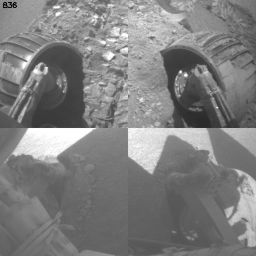 Breaking free of Jammerbugt
Breaking free of JammerbugtIn May, Opportunity encountered dangerously sandy terrain on the vast plains leading to the rover's next major destination, Victoria Crater and wound up on a sand-jam on a dune dubbed Jammerbugt. This series of images from the front and rear hazard-avoidance cameras reveal the challenge the rover faced to free itself. Each quadrant shows one of the rover's four corner wheels: left front wheel in upper left, right front wheel in upper right, rear wheels in the lower quadrants. The wheels became partially embedded in the ripple at the end of a drive on Sol 833 (May 28, 2006). The wheels reached solid footing on a rock outcrop after 6 extraction drives on Sol 841 (June 5-6) and the rover was back on the road to Victoria.Credit: NASA / JPL-Caltech / Cornell
At Meridiani Planum, Opportunity -- with a little help from its devoted drivers -- managed to maneuver itself free from Jammerbugt, the dune it first backed into on Sol 830 (May 24) to increase its northerly tilt. Once free, the rover imaged the culprint surroundings and then got back on the Meridiani highway headed toward Victoria crater. [The dune was named for a Jammerbugt bay on the north coast of Denmark, loosely translated as the Bay of Wailing, known for its many shipwrecks.] Scientists and engineers who had been elated at the meters of progress the rover had been making in earlier drives were happy for even centimeters of advance per sol as they maneuvered their explorer through the slippery material of Jammerbugt. It took six, precise maneuvers over about a week's time, but the process worked.
It was very slow going at first, with 5 meters (16 feet) of commanded motion ordered on Sol 833 (May 31), the first day of extraction, but the rover only managed to make 9 centimeters (3.5 inches of actual forward progress. If that seems agonizingly slow, it really wasn't -- actually 3.5 inches is more than 3 times the rate of Opportunity's progress experienced during the Purgatory Dune extractions in April and May 2005. The rover continued the maneuvering the next day and made another 8 centimeters (3.1 inches) of forward progress.
On Sol 838 (June 2), Opportunity began a 3-sol weekend plan with three identical extraction drives planned. In 10 meters (33 feet) of commanded motion, the rover only pushed onward for 4.2 centimeters (1.7 inches) and the wheels became more caked, a little too reminiscent of Purgatory for the engineer's liking. The next day and the fourth extraction added another 5 centimeters (2 inches) of progress and the wheels appeared cleaner. On Sol 840, Opportunity broke free, making 28 centimeters (11 inches) of forward progress. In the images the rover returned after the drive, the front wheels were significantly less buried and they were cleaner.
During the sixth extraction effort on Sol 841 (June 5-6), Opportunity all but cruised for 2.8 meters (9.2 feet) and wound up with all six wheels on firmer, outcrop ground. Since this sol began on June 5, Danish Constitution Day, the rover team decided to use Danish names for targets in the area of Opportunity's current location in honor of their Danish colleagues. Denmark provided magnet arrays for Opportunity's and Spirit's studies of airborne dust.
Once freed, on Sol 842 (June 7), Opportunity roved back toward the culprit terrain to take high-resolution imaging of Jammerbugt, much like it had after it escaped the clutches of Purgatory. The following day, the rover retraced its steps to another outcrop patch, ready to get back on track to Victoria. The only significant stop before that is scheduled for Beagle crater, the last major roadside attraction before Victoria. Opportunity hit the highway, roving down a tough parallel to the one the team had previously chosen where it had gotten stuck. This one wasn't kind, though, and neither was the next one.
The third time is the charm and despite a rough start in a couple of troughs, Opportunity moved one more trough to the west and hit the road. From Sol 844 (June 9) to Sol 851 (June 16), Opportunity made up tracks for lost time, roving approximately 95 meters (312 feet) closer to Victoria. In that timeframe, the rover also took some rear-looking images with its navigation camera, conducted targeted remote sensing with its PanCam, imaged targets dubbed Jylland and Gorm, and checked out Gorm with the mini-TES, as well as conducted some atmospheric science.
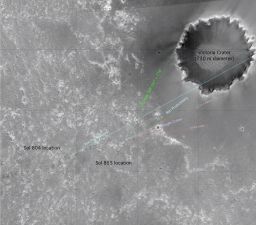 Beagle Crater on Opportunity's horizon
Beagle Crater on Opportunity's horizonThis image from the Mars Orbiter Camera onboard Mars Global Surveyor highlights the Opportunity's approach toward Beagle Crater. North is to the left. Opportunity's locations at Sols 804 (April 29, 2006) and 855 (June 20, 2006) are marked, as are the left and right edges of the rim of Victoria Crater from the rover's point of view. The labeled "promontory" is a bright spot that scientists originally thought was an outcrop but further investigation indicates this outcrop must instead be on the near rim of the crater. Marked in salmon are two small craters beyond Beagle crater that are on the dark "annulus," or ring, around Victoria Crater. This image is an uncalibrated version that the rover team uses for planning. It has been reprojected and stretched in some places and isn't used for scientific purposes.Credit: NASA / JPL-Caltech / MSSS / OSU
On Sol 848, the team instructed Opportunity to take a picture of a small crater named Sjaelland for the biggest island of Denmark, and the site of the capital, and then to turn around on a piece of outcrop so it could drive backwards to improve its UHF data return. It drove down a trough and logged 20.6 meters (68 feet of progress) and on the following day logged another 24 meters (79 feet) of progress. On Sol 850, the rover began its day by taking a PanCam image of a target dubbed Steno -- after Niels Steensen or Nichaola Steno, a 17th century Danish anatomist and geologist. Then, Opportunity got back on the Meridiani highway, cruising an autobahn of outcrop that allowed it to log another 36 meters (118 feet) onto the odometer.
In the last 2 weeks, Opportunity roved for another 240 meters and is now in view of Beagle crater. As it's traveled, the rover imaged targets of interest, including Holberg and Blixen, both of which it also examined with its mini-TES, and checked for clouds with its navigation camera and conducted an assessment of tau, or clarity of the atmosphere, with the PanCam. With Beagle crater around the corner and the rim of Victoria now well in view, the prime directive is still to drive.
"We're just chugging along," said Squyres. "Our immediate goal is Beagle crater. This crater, of course, is named after Darwin's ship -- the HMS Beagle -- that he used in his explorations of the Galapagos and other places, but it's also a tip of the hat to our British colleagues who tried to land on Mars the same time we did." He checked, he said, with Beagle2's father Colin Pillinger to make sure he was okay with that. Pillinger was.
Opportunity is currently about 200 meters (656 feet) from Beagle crater, and closing in slowly. "We can see it clearly on the horizon now," said Squyres. This crater is about 35 to 40 meters in diameter and looks "quite fresh." The rover, however, has encountered some of the most treacherous terrains seen on the whole mission, "so it could take a while," he added. "We just have to pick our way carefully. We're literally working our way through a maze right here. Having just had a little wake-up call there with Jammerbugt, we're being really careful." Even so, in recent days, Opportunity is typically getting 35 to 40 meters per drive, "so we're going along at a nice clip," he said.
"At Beagle, we're going to see what we see," Squyres continued. "It's the first really fresh crater we've seen in quite a while. We're going to take a look at it and my expectation is that we'll do some in situ work there." After that, Opportunity will continue on as planned, to the rim of Victoria, which will still then be about 480 meters (.3 mile) or so away.
"The interesting thing is once you get beyond Beagle, the nature of the terrain changes rather dramatically as you can see in the orbital images," Squyres points out. "When you look at the orbital images, you can clearly see the terrain we're in right now is covered by these huge ripples and it looks treacherous, but just south of Beagle, all the ripples stop and it's an absolutely gray, featureless surface." What that means, they don't know.
"Our hope of course is that it's just a flat sand-sheet like the rover encountered after it emerged from Eagle crater into which it rolled to a stop in January 2004," Squyres offered. "You will recall that the drive from Eagle to Endurance went very, very quickly because it was just easy going. We're hoping it's going to be like that," he said. But nothing is simple and on Mars, and this carpet of smooth surface material that seems to completely surround Victoria is "weird," by Squyres reckoning. "Clearly, it has something to do with the crater," he said. "But we don't really know or understand what the stuff is, so we're going to tiptoe pretty cautiously. If it turns out that it is easy driving, then the last 400 to 500 meters to Victoria should be quite simple. But," he cautioned, "if it's something treacherous, then all bets are off."
Support our core enterprises
Your support powers our mission to explore worlds, find life, and defend Earth. You make all the difference when you make a gift. Give today!
Donate

 Explore Worlds
Explore Worlds Find Life
Find Life Defend Earth
Defend Earth


